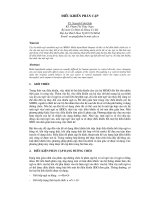Điều khiển ADO.NET pptx
Bạn đang xem bản rút gọn của tài liệu. Xem và tải ngay bản đầy đủ của tài liệu tại đây (817.72 KB, 41 trang )
Điều khiển ADO.NET
Hầu hết ứng dụng hay các website đều cần phải có cơ sở dữ liệu, để lưu trữ dữ liệu, xử
lý thông tin và đưa ra các báo cáo, hỗ trợ tìm kiếm…
Khi dữ liệu trở thành trung tâm của ứng dụng thì cung cấp các chức năng tới người
dùng phụ thuộc vào khả năng thao tác dữ liệu, vấn đề mà người thiết kế và người xây dựng
ứng dụng quan tâm khi sử dụng dữ liệu là:
Lưu dữ liệu tập trung
Đảm bảo toàn vẹn dữ liệu
Đảm bảo khả năng truy xuất đồng thời của nhiều người dùng trên dữ liệu
Đảm bảo thời gian hồi đáp ngắn cho mỗi người dùng
Bảo mật dữ liệu
Trao đổi dữ liệu giữa các hệ thống khác nhau
Những vấn đề này được giải quyết dựa vào khả năng của các hệ quản trị cơ sở dữ
liệu(HQT CSDL) và các phần mềm xử lý dữ liệu do HQL CSDL cung cấp. Net truy xuất dữ
liệu qua ADO.NET, đặc điểm chính của ADO.NET là khả năng làm việc vơi dữ liệu không kết
nối, dữ liệu được lưu trữ trong bộ nhớ như một csdl thu nhỏ gọi là dataset, nhằm tăng tốc
độ tính toán, xử lý tính toán và hạn chế sử dụng tài nguyên trên Database Server. ĐẶc điểm
quan trọng thứ 2 là khả năng xử lý dữ liệu chuẩn XML, dữ liệu ở dạng XMl có thể trao đổi
giữa bất kỳ hệ thống nào nên ứng dụng của bạn sẽ có nhiều khả năng làm việc với nhiều
ứng dụng khác.
I. Kiến trúc ADO .Net
Hình 1
Kiến trúc ADO.NET có thể chia làm 2 phần chính:
- Managed Provider Component: bao gồm các đối tượng như
DataAdapter, DataReader,… giữ nhiệm vụ làm việc trực tiếp với dữ
liệu như database, file,…
- Content Component: bao gồm các đối tượng như DataSet,
DataTable,… đại diện cho dữ liệu thực sự cần làm việc. DataReader là
đối tượng mới, giúp truy cập dữ liệu nhanh chóng nhưng forward-only
và read-only giống như ADO RecordSet sử dụng Server cursor,
OpenFowardOnly và LockReadOnly.
DataSet cũng là một đối tượng mới, không chỉ là dữ liệu, DataSet có
thể coi là một bản sao gọn nhẹ của CSDL trong bộ nhớ với nhiều bảng
và các mối quan hệ.
DataAdapter là đối tượng kết nối giữa DataSet và CSDL, nó bao gồm 2
đối tượng Connection và Command để cung cấp dữ liệu cho DataSet
cũng như cập nhật dữ liệu từ DataSet xuống CSDL.
Trước khi đi vào học cụ thể các đối tượng của ADO.NET chúng ta cùng xem qua một ví
dụ HelloWorld với ADO.NET qua đó bạn sẽ thấy được công việc cần thực hiện khi thao tác
với database(ở ví dụ này mình dùng với SQLExpress).
Để làm ví dụ này bạn thực hiện theo các bước sau:
bước 1. Nhấn chuột phải vào thư mục App_Data chọn new Item, Cửa sổ Add New
Item hiện ra bạn chọn SqlDatabase như hình 1 sau
Hình 2
bước 2. Nhập tên Database vào hộp Name sau đó nhấn Add.
Trong Solution Explorer sẽ thêm vào Database trong thư mục App_Data.
Hình 3
bước 3. tạo bảng dữ liệu cho Database.mdf
o bước 3.1 bạn click đúp chuột vào Datatabase.mdf -> Server Explorer hiện ra
như sau:
Hình 4
o bước 3.2 bạn nhấn chuột phải vào Tables và chọn Add New Table
Hình 5
Trong màn hình của VS sẽ hiện ra như hình 6 và bạn thao tác tạo các trường dữ liệu
như thao tác với Access hay MSSQL 2000/2005
Hình 6
bước 4.Viết code cho Hello.aspx.cs
using System;
using System.Data;
using System.Data.SqlClient;
public partial class _Default : System.Web.UI.Page
{
protected void Page_Load(object sender, EventArgs e)
{
//chuỗi kết nối đến nguồn dữ liệu
string driver = "Data
Source=(local)\\SQLEXPRESS;AttachDbFilename=|DataDirectory|Database.mdf;Integ
rated Security=True;User Instance=True";
//đối tượng kết nối tới cơ sở dữ liệu
SqlConnection sqlconn = new SqlConnection(driver);
//Command điều khiển truy vấn sql
SqlCommand sqlcom = sqlconn.CreateCommand();
sqlcom.CommandText = "select sTitle from tblHello where pkHelloID=1";
//mở kết nối dữ liệu
sqlconn.Open();
//lấy về chuỗi giá trị trong cơ sở dữ liệu
string result = (string)sqlcom.ExecuteScalar();
//đóng kết nối
sqlconn.Close();
//in giá trị ra màn hình
Response.Write(result);
}
}
Cơ bản các bước thực hiện với database
bước 1: Tại kết nối
bước 2: Tạo lệnh điều khiển truy vấn SQL
bước 3:Mở kết nối dữ liệu
bước 4: thực thi lệnh
bước 5: đóng kết nối
bước 6: in kết quả
II. Đối tượng Connection
Kết nối cơ sở dữ liệu SQLServer
Bạn cần nhập khẩu lớp SqlClient
using System.Data.SqlClient;
Khai báo và khởi tạo:
SqlConnection sqlcon;
string driver="server=localhost; UID=sa; PWD=; database=name_database";
sqlcon=new Sqlconnection();
sqlcon.ConnectionString=driver;
Driver là chuỗi kết nối đến cơ sở dữ liệu trong trường hợp này mình kết nối với
sqlserver 2000/2005
Kết nối với cơ sở dữ liệu Access
Bạn cận nhập khẩu lớp OleDb
using System.Data.OleDb;
OleDbConnection oleconn;
string driver = "Provider=Microsoft.jet.OLEDB.4.0; Data
Source=duongdan_tendata";
oleconn = new OleDbConnection();
oleconn.ConnectionString = driver;
1. Thuộc tính:
ConnectString: chứa đựng chuỗi kết nối tới cơ sở dữ liệu
Database: Chứa đựng tên cơ sở dữ liệu trong chuỗi kết nối ConnectString ở trên và
bạn có thể thay đổi cơ sở dữ liệu trong lúc thực thi bằng phương thức ChangeDataBase:
Sqlconn.ChangeDatabase(“name_database_thaydoi”);
Server: tên máy chủ bạn trỏ tới
Connect Timeout: số thời gian(tính bằng giây) chờ kết nối dữ liệu mặc đình là
15giây, nếu trong khoảng thời gian này mà vẫn chưa kết nối xong một lỗi Connect Timeout
được đưa ra.
State: trả về trạng thái của đối tượng SqlConnection: bạn có thể kiểm tra trạng thái
của State như sau
Response.Write(sqlconn.State)
2. Phương thức của đối tượng Connection
Các phương thức của đối tượng Connection
Open: cho phép mở dữ liệu với các thuộc tính đã khai báo trong ConnectString
Close: Đóng cơ sở dữ liệu đang mở
CreateCommand: phương thức cho phép gán hay trả về một đối tượng Command ứng
với đối tượng Connection, như ví dụ HelloWorld
SqlConnection sqlconn = new SqlConnection(driver);
SqlCommand sqlcom = sqlconn.CreateCommand();
sqlcom.CommandText = "select sTitle from tblHello where pkHelloID=1";
BeginTransaction: Phương thức này khai báo bắt đầu một chuyển tác, để kết thúc
chuyển tác bạn dùng Table Commit
Rollback: trong trương hợp có lỗi trong quá trình thực thi bạn có thể sử dụng phương
thức Rollback để huỷ bỏ các chuyển tác đã thực hiện.
Dispose: dùng để huỷ bỏ hay giải phóng đối tượng Connection đang sử dụng
III. Đối tượng SqlCommand
Khai báo và khởi tạo đối tượng
Cách 1:
SqlCommand sqlcom;
sqlcom=new SqlCommand(ssql,sqlconn)
cách 2:
SqlCommand sqlcom = new SqlCommand();
sqlcom.Connection = sqlconn;
sqlcom.CommandType = CommandType.Text;
sqlcom.CommandText = "select sTitle from tblHello where pkHelloID=1";
Phương thức
- ExcuteReader: dùng để thực thi đọc cơ sở dữ liệu từ bảng cơ sở dữ liệu
- ExcuteNoneQuery: Dùng để thực thi các phát biểu T-Sql như: Insert, Update, Delete,
Create,…
- ExcuteScalar: trả về từ phát biết SQL dạng Select chỉ có một cột một hàng.
IV. Đối tượng SqlDataReader
đối tượng này được net cung cấp để đọc dữ liệu từ bảng cơ sở dữ liệu, nó là đối tượng chỉ
phục vụ thao tác đọc dữ liệu(Read only). Trong khi truy xuất dữ liệu nó sẽ giữ kết nối liên tục
với database(hướng kết nối)
Khai báo và khởi tạo đối tượng
SqlDataReader sqlreader;
sqlreader = sqlcom.ExecuteReader();
V. Đối tượng DataAdapter
OleDataAdapter được xem như bộ đọc dữ liệu từ cơ sở dliệu nguồn và điền chúng vào đối
tượng DataSet hay DataTable
Khai báo, khởi tạo và giải phóng đối tượng.
string ssql;
Khai báo đối tượng
Dim sqlcom As SqlCommand
Dim sqlconn As SqlConnection
Dim sqladapter As SqlDataAdapter
sqlconn.Open();
cách 1.
sqladapter = New OleDbDataAdapter(ssql, sqlconn)
sqlcom = New SqlCommand(ssql, sqlconn)
cách 2.
sqladapter = new SqlDataAdapter(sqlcom);
Giải phóng đối tượng
sqladapter.Dispose();
Thuộc tính:
Các thuộc tính bao gồm SelectCommand, InsertCommand, UpdateCommand,
DeleteCommand: thực hiện các thao tác select, insert, update, delete dữ liệu
Phương thức:
Fill: Phương thức thực thi câu lệnh select trong sql rồi điền kết quả cho DataSet hoặc
Datatable.
Update: gọi lệnh câph nhật các thay đổi vào dữ liệu lên các dữ liệu nguồn
Điền dữ liệu từ Adapter vào DataSet
Dataset là một thùng chứa dữ liệu không kết nối
public static DataSet Filldataset(string ssql)
{
DataSet dataset = new DataSet();
opendata();
try
{
sqladapter = new SqlDataAdapter(ssql, sqlconn);
sqladapter.Fill(dataset);
sqladapter.Dispose();
}
catch (Exception exp)
{
closedata();
System.Web.HttpContext.Current.Response.Write(exp.ToString())
;
}
closedata();
return dataset;
}
Điền dữ liệu vào DataTable
public static DataTable FillDatatable(string ssql)
{
opendata();
DataTable datatable = new DataTable();
try
{
sqladapter = new SqlDataAdapter(ssql, sqlconn);
sqladapter.Fill(datatable);
sqladapter.Dispose();
}
finally
{
closedata();
}
closedata();
return datatable;
}
VI. Đối tượng Dataset và DataTable
Là thành phần chính của kiến trúc không kết nối cơ sở dữ liệu, được dùng để nắm giữ dữ
liệu của mọi cơ sở dữ liệu và cho phép thay đổi dữ liệu bên trong đối tượng này để sau đó cập
nhật trở lại cơ sở dữ liệu nguồn bằng phương thức Update của đối tượng DataAdapter
Khởi tạo
DataSet dataset = new DataSet();
DataSet dataset = new DataSet("Mydataset");
Thuộc tính Tables, dataset được dùng để chứa danh sách các đối tượng DataTable
Ví dụ:
private void button1_Click(object sender, EventArgs e)
{
string strQuery = "select * from tblEmployees";
DataSet dataSet = new DataSet("Employees");
try
{
SqlDataAdapter sqlDataAdapter = new
SqlDataAdapter(strQuery, Connection.sqlConnection);
sqlDataAdapter.Fill(dataSet);
sqlDataAdapter.Dispose();
}
catch (Exception ex)
{
MessageBox.Show("Error: " + ex.Message);
}
this.dataGridView1.DataSource = dataSet.Tables[0];
//lay ve ten cua doi tuong dataset
label1.Text ="DataSetName: " + dataSet.DataSetName ;
}
private void button2_Click(object sender, EventArgs e)
{
//khai bao phat bieu sql 1
string strQuery = "select * from tblEmployees";
DataSet dataSet = new DataSet("Employees");
try
{
SqlDataAdapter sqlDataAdapter = new
SqlDataAdapter(strQuery, Connection.sqlConnection);
sqlDataAdapter.Fill(dataSet);
//khai bao phat bieu sql 2
strQuery = "select * from tblContracts";
sqlDataAdapter = new
SqlDataAdapter(strQuery, Connection.sqlConnection);
DataTable dataTable = new DataTable();
sqlDataAdapter.Fill(dataTable);
dataSet.Tables.Add(dataTable);
sqlDataAdapter.Dispose();
string dataTableName="";
foreach(DataTable dt in dataSet.Tables)
{
dataTableName += dt.TableName + " ";
}
label1.Text = "Number of tables: " + dataTableName ;
}
catch (Exception ex)
{
MessageBox.Show("Error: " + ex.Message);
}
this.dataGridView1.DataSource = dataSet.Tables[1] ;
}
Phuong thuc Add, Remove
DataSet dataset=new DataSet();
DataTable datatable=new DataTable(“datatablename”);
dataset.Tables.Add(datatable);
dataset.Tables.Remove(datatable);
xoa voi datatable duoc dat tên
dataset.Tables.Remove(datatablename);
dataset.Tables.RemoveAt(0);
phương thức Clear loại bỏ tất cả các đối tượng trong DataTable
dataset.Tables.Clear();
De dem so dong du lieu trong bang ta co the thuc hien
int sodong=dataset.Tables[0].Rows.Count;
2. Đối tượng DataTable
private void button1_Click(object sender, EventArgs e)
{
string strQuery = "select top 10 * from tblEmployees";
//khoi tao doi tuong DataTable
dataTable = new DataTable("Employees");
try
{
SqlDataAdapter sqlDataAdapter = new
SqlDataAdapter(strQuery, Connection.sqlConnection);
//dien du lieu vao datatable
sqlDataAdapter.Fill(dataTable);
sqlDataAdapter.Dispose();
}
catch (Exception ex)
{
MessageBox.Show("Error: " + ex.Message);
}
//gan du lieu va dataGrid voi thuoc tinh DataSource
this.dataGridView1.DataSource = dataTable;
label1.Text= dataTable.TableName ;
}
// thuoc tinh DataRow tra ve cac mau tin dang chua trong doi tuong DataTable
private void button2_Click(object sender, EventArgs e)
{
if (dataTable != null)
{
string name = "";
foreach (DataRow dataRow in dataTable.Rows)
{
name += Convert.ToString(dataRow[1]) + "\n";
}
label1.Text = name;
}
}
//thuoc tinh Columns tra ve tap doi tuong DataColumn bao gom danh sach cot du
lieu cua bang chua trong doi tuong DataTable
private void button3_Click(object sender, EventArgs e)
{
if (dataTable != null)
{
string name = "";
foreach (DataColumn dataColumn in dataTable.Columns)
{
name += Convert.ToString(dataColumn.ColumnName) + "\n";
}
label1.Text = name;
}
}
Ví dụ chúng ta sẽ ứng dụng 3 dối tượng trên vào việc, cập nhật và hiển thị dữ liệu cho
bảng sản phẩm
Bước 1: tạo bảng cơ sở dữ liệu
Ví dụ chúng ta có một bảng dữ liệu tblIntrodure gồm các trường:
pkIntrodureID (int)
sTitle (nvarchar(300)
sSummary (nText)
iContent (nText)
iPosition (int)
Bước 2: tạo thủ tục StoreProcedure
ta tạo ra 3 thủ tục sql cho bảng giới thiệu của ta như sau
spIntrodure_insert - Thủ tục thêm mới dữ liệu
Create PROCEDURE spIntrodure_insert
@sTitle nvarchar(100),
@sSummary ntext,
@sContent ntext,
@iPosition int
AS
insert into tblIntrodure(sTitle, sSummary, sContent, iPosition)
values(@sTitle, @sSummary, @sContent, @iPosition)
GO
spIntrodure_edit - Thủ tục sửa dữ liệu
Create PROCEDURE spIntrodure_edit
@pkIntrodureID int,
@sTitle nvarchar(100),
@sSummary ntext,
@sContent ntext,
@iPosition int
AS
update tblIntrodure set
sTitle=@sTitle, sSummary=@sSummary, sContent=@sContent,
iPosition=@iPosition
where pkIntrodureID=@pkIntrodureID
GO
spIntrodure_deletebyID - Thủ tục xoá dữ liệu
Create PROCEDURE spIntrodure_deletebyID
@pkIntrodureID int
AS
delete from tblIntrodure where pkIntrodureID=@pkIntrodureID
GO
Chú ý: trên là cách tạo 3 thủ tục theo cú pháp của MSSQL nếu bạn tạo thủ tục SQL trong
VS thì từ khoá Create sẽ chuyển thành Alter và GO chuyển thành Return
Bước 3: Tạo các lớp(nằm trong thư mục App_Code)
IntrodureInfo.cs
using System;
namespace iTechPro.Modules.Introdure
{
public class IntrodureInfo
{
int _pkIntrodureID;
public int pkIntrodureID
{
get { return _pkIntrodureID; }
set { _pkIntrodureID = value; }
}
string _sTitle;
public string sTitle
{
get { return _sTitle; }
set { _sTitle = value; }
}
string _sImage;
public string sImage
{
get { return _sImage; }
set { _sImage = value; }
}
string _sSumary;
public string sSumary
{
get { return _sSumary; }
set { _sSumary = value; }
}
string _sComment;
public string sComment
{
get { return _sComment; }
set { _sComment = value; }
}
int _iPosition;
public int iPosition
{
get { return _iPosition; }
set { _iPosition = value; }
}
}
}
IntrodureDB.cs (chứa tất cả phương thức xử lý và lấy dữ liệu cho bảng tblIntrodure)
using System;
using System.Data;
using System.Data.SqlClient;
using Website.Library;
namespace Website.Modules.Introdure
{
public class IntrodureDB : ExcuteDataHelper
{
public IntrodureDB()
{
//
// TODO: Add constructor logic here
//
}
public static void Delete(string _pkIntrodureID)
{
string[] parameters = new string[] { "@pkIntrodureID"};
string[] values = new string[] { _pkIntrodureID};
executeData("spIntrodure_deletebyID", parameters, values);
}
public static void Insert(IntrodureInfo _introdure)
{
string[] parameters = new string[7] { "@sTitle", "@sImage",
"@sSumary", "@sComment", "@sPage", "@sLang", "@iPosition" };
string[] values = new string[7] { _introdure.sTitle,
_introdure.sImage, _introdure.sSumary, _introdure.sComment, _introdure.sPage,
_introdure.sLang, _introdure.iPosition.ToString() };
executeData("spIntrodure_insert", parameters, values);
}
public static void Update(IntrodureInfo _introdure)
{
string[] parameters = new string[7] { "@pkIntrodureID"
,"@sTitle", "@sImage", "@sSumary", "@sComment", "@sPage", "@iPosition" };
string[] values = new string[7] {
_introdure.pkIntrodureID.ToString(), _introdure.sTitle, _introdure.sImage,
_introdure.sSumary, _introdure.sComment, _introdure.sPage,
_introdure.iPosition.ToString() };
executeData("spIntrodure_edit", parameters, values);
}
public static void UpdateIndex(string _pkIntrodureID, string _giatri)
{
string ssql = "update tblIntrodure set iPosition=" + _giatri + "
where pkIntrodureID=" + _pkIntrodureID;
executeData(ssql);
}
public static IntrodureInfo Getinfo(string _pkIntrodureID)
{
DataTable mydata =
iTechProData.FillDatatable("spIntrodure_selectbyID", "@pkIntrodureID",
_pkIntrodureID);
IntrodureInfo _introdure = new IntrodureInfo(); ;
_introdure.sTitle = mydata.Rows[0]["sTitle"].ToString();
_introdure.sImage = mydata.Rows[0]["sImage"].ToString();
_introdure.sSumary = mydata.Rows[0]["sSumary"].ToString();
_introdure.sComment = mydata.Rows[0]["sComment"].ToString();
_introdure.sPage = mydata.Rows[0]["sPage"].ToString();
_introdure.sLang = mydata.Rows[0]["sLang"].ToString();
_introdure.iPosition =
int.Parse(mydata.Rows[0]["iPosition"].ToString());
return _introdure;
}
}
}
Tại lớp IntrodureDB này chúng ta sẽ kế thừa các phương thức thực thi dữ liệu từ lớp
ExcuteDataHelper.cs
Lớp ExcuteDataHelper.cs
using System;
using System.Data;
using System.Data.SqlClient;
namespace Website.Library
{
public class ExcuteDataHelper : iTechProData
{
//phuong thuc thuc thi du lieu(them moi, chinh sua, xoa) khi dua vao
mot tham so sql
#region executeData(string sql)"Thực thi dữ liệu"
public static void executeData(string sql)
{
opendata();
sqlcom = new SqlCommand(sql, sqlconn);
try
{
sqlcom.ExecuteNonQuery();
closedata();
}
catch (Exception exp)
{
closedata();
HttpContext.Current.Response.Write(sql + "<br/>");
HttpContext.Current.Response.Write("Có lỗi trong quá trình
thực thi " + exp.ToString());
}
}
#endregion
//phuong thuc thuc thi du lieu voi tham so dua vao
#region executeData(string store, string[] Parameter, string[]
Values)
public static void executeData(string store, string[] Parameter,
string[] Values)
{
opendata();
sqlcom = new SqlCommand();
sqlcom.CommandText = store;









